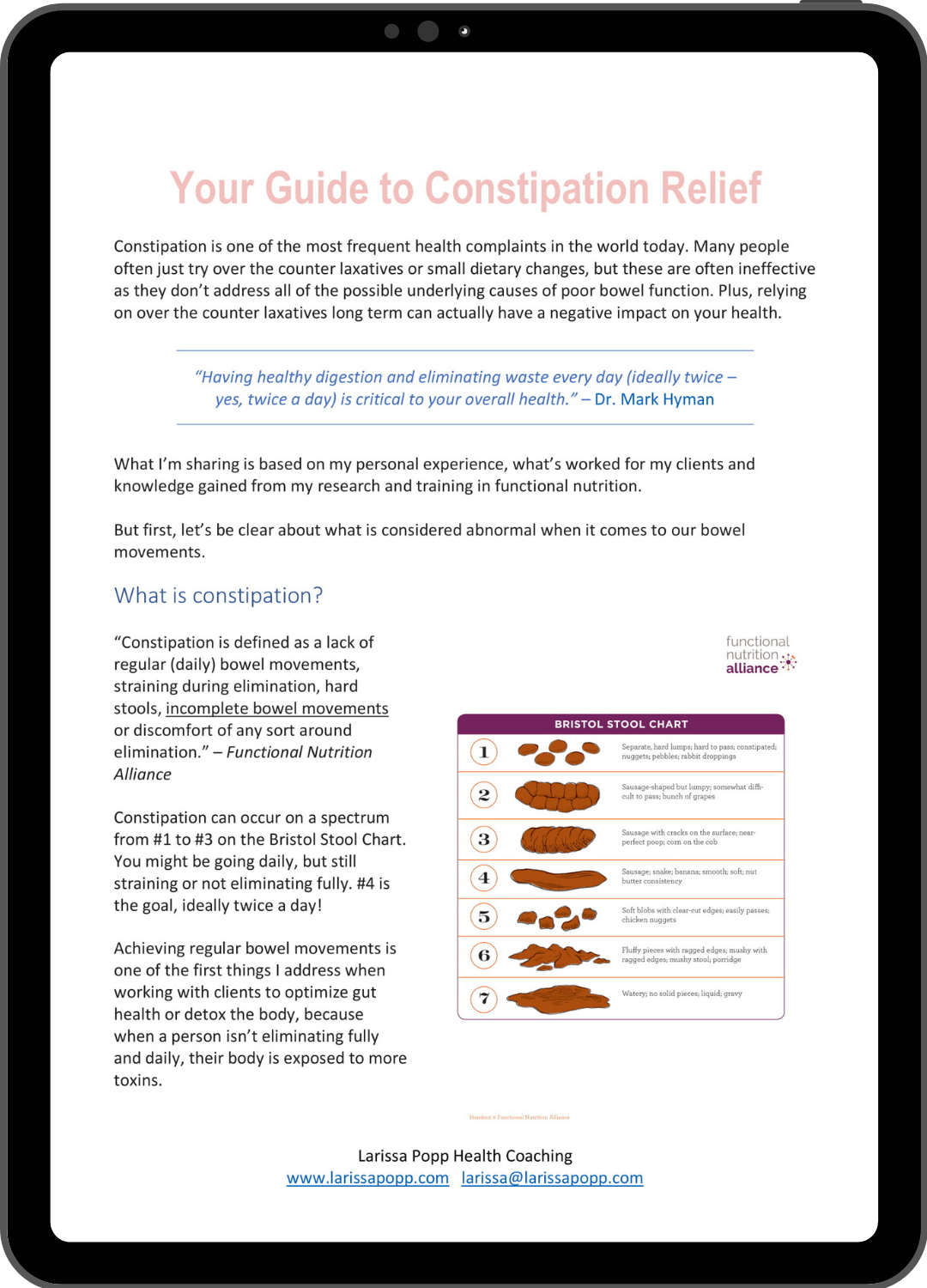
I talked last week about fiber, and shared that you should be aiming for 40 grams of fiber per day (or slowly working up to that amount).
The best way to get that 40 grams/day is to start your day with a high-fiber breakfast. This will also set you up for a more energetic and productive day as you’ll be much more likely to have steady energy and satiety throughout your morning and the rest of your day.
1. Add high-fiber fruit and seeds to your oatmeal (or quinoa porridge)
Best oat options:
- Yes, oats can help lower cholesterol. They contain a special type of fiber called beta-glucan, but it’s best to choose rolled oats or steel cut oats over instant oats (which have less fiber). Watch this video to learn What Happens to Body When You Eat Oatmeal Every Day!
- Avoid Quaker’s oats and buy only organic oats. Check out this list to see the results of glyphosate testing in common brands of oats (Bob’s Red Mill is a good brand). Glyphosate is the active ingredient in Roundup weed killer and it has been found in most samples of conventional, and even in some organic oats — it’s believed to be linked to cancer and other diseases, and has been patented as an antibiotic so it can disrupt the healthy bacteria in your gut, which are so essential for optimal health.
- Fiber content of oats: 5 grams fiber in ¼ cup dry steel-cut oats, 4 grams fiber in ½ cup dry rolled oats, 3 grams fiber in ½ cup instant oats
Best fruit options:
- Berries are among the most nutrient dense fruits (and recommended to be eaten daily for brain health), and they are also considered a high fiber fruit. Raspberries win the fiber race at 4 grams of fiber per ½ cup, and luckily they’re also delicious with oatmeal (I always keep a bag of frozen raspberries in my freezer).
- Apples are also high in fiber, and by cooking them (with the skin on) the pectin fiber is released and more easily available to feed the good gut bacteria in your gut. Try making stewed apples and add 2 spoonfuls to your oatmeal. See my post “3 Tips for a Healthy Microbiome” to learn how to make stewed apples.
- Other high-fiber fruit to add to your oats: pears, pomegranates, bananas, apricots, cherries, persimmons, and certain tropical fruits including passion fruit, guava and mango. (1)
Best nut and seed options (2):
All nuts and seeds will give you fiber and go great in oatmeal, either whole or ground, but here’s the top 6, in order, with highest fiber content by weight:
- #1 Chia seeds (whole or ground) → 5 grams of fiber per tablespoon!
- #2 Flax seeds (ground) → chia and flax both contain lignans as well which have powerful anti-cancer effects, but flax has 3x more lignans than chia seeds so I try to always have a tablespoon a day.
- #3 Pumpkin seeds → also a great source of magnesium, a mineral most people are deficient in
- #4 Dried Coconut → tip: toast unsweetened coconut flakes to give added flavor
- #5 Sesame Seeds → tip: try grinding toasted sesame seeds in a spice grinder then mixing into your oatmeal (this is another of my new favorite oatmeal mix-ins)
- #6 Almonds → tip: consider adding a dollop or drizzle of almond butter on top of your oatmeal (it’s my new favorite topping!)
My favorite oatmeal combo at the moment (adapted from a pre-workout recipe by Maddie Lymburner):
Ingredient to cook with oats:
- ½ cup rolled oats (though Maddie used instant to make this oatmeal an easily digestible pre-workout meal) = 4 grams fiber
- 2 Tbsps ground seeds (For taste I love the combo from Maddie’s video of 1 tbsp toasted sesame seeds (1 gram fiber) + 1 Tbsp raw sunflower seeds (1 gram fiber), and for variety of nutrients I rotate with 1 tbsp ground flax + 1 tbsp ground pumpkin seeds
- ½ cup non-GMO soymilk + ½ cup water (or I sometimes sub for homemade cashew milk lightly sweetened with dates) = 1-2 grams fiber (Soy has been shown to significantly reduce the risk of breast cancer and help breast cancer patients fight off cancer as well, but its recommended to only consume non-GMO soy as GMO soy can end up leading to gut permeability issues)
- ½ tsp ceylon cinnamon powder = .5 gram fiber
- ½ tsp organic pure vanilla extract.
A note about grinding seeds, esp. flax seeds: First off, it’s best to keep raw seeds in the refrigerator or freezer for longer shelf life, esp. flax seeds. I use a basic spice/coffee grinder to quickly turn my seeds into a powder and you can make a large batch and keep it in the fridge for a few weeks at a time. For flax seeds in particular you always want to buy whole ones and grind yourself, keep in the fridge and use within 3-4 days of grinding for maximum freshness (or I’ve read that ground flax can keep up to 6 months in the freezer — but I feel freshly ground is better; and the whole flax seeds can be kept up to a year in the freezer) — the oils in flax will easily be oxidized when exposed to air, heat and/or light which leads to rancid oil and rancid oil will be full of free radicals, which are rogue molecules that bombard and destroy your healthy cells. This is why I prefer to buy sprouted ground flaxseed (affiliate link) which are MUCH more shelf stable and in my opinion taste better because it has a nuttier flavor.
Oatmeal toppings:
- 1 small/medium banana, sliced = 3 grams fiber
- ½ cup red raspberries to put on top = 4 grams fiber
- 1 large spoonful of homemade almond butter (with cinnamon, vanilla and a tad maple syrup) = 2-3 grams fiber
- Extra non-GMO soy milk (or other milk alternative)
Total fiber = 16-18 grams
2. Add avocado to a smoothie & make it into a high-fiber smoothie bowl
- In addition to being a healthy fat, avocado is actually a very high-fiber fruit (with an average of 13 grams of fiber per fruit, depending on its size), AND it goes great mixed into smoothies to thicken them up for a smoothie bowl. Just add a 1/4-1/3 an avocado per serving.
- I think smoothie bowls are better than smoothies because you can add other high-fiber toppings like any of the high-fiber fruits and it feels more like you’re eating a meal + you are forced to chew so you’ll likely digest the smoothie better than if you just guzzled it down from a glass. I love to sprinkle this sprouted ground flaxseed (affiliate link) on my smoothie bowls. Just one tablespoon a day of flax seed can significantly reduce the risk of breast cancer.
- Try making my go-to-green smoothie with less water and avocado added to make it into a smoothie bowl. Or try this Super Green Smoothie Bowl Recipe by Minimalist Baker (whose recipes I love!)
3. Have beans for breakfast
Beans are super high in fiber (8 grams in 1/2 cup black beans for example) and part of Dr. Greger’s Daily Dozen (author of How Not to Die) and Dr. Fuhrman’s G-BOMBS. They are a very important part of a healthy longevity lifestyle. All blue zone populations include beans in their diets.
Try this black bean chocolate smoothie. You will be surprised how delicious it tastes! It also contains frozen cauliflower which you won’t taste at all either! It’s not only high-fiber, but also high-protein (without even needing protein powder). And since the beans are blended they are less likely to cause gas, as long as you make sure to also “chew” your smoothie as chewing is the first step to good digestion — I like to sprinkle on some cacao nibs to make it easier to chew.
4. Make chia pudding → Try the recipe below.
Very Berry Chia Pudding
Ingredients (for 2 servings):
1 cup unsweetened vanilla almond, cashew, or non-GMO soy milk
2 tbsp ground chia seeds
½ cup raspberries*, chopped
¼ cup blueberries*, chopped
Note: If you don’t have fresh, you can use any type of frozen berries, I love to keep frozen red raspberries and wild blueberries in my freezer when possible (I like the taste of wild blueberries more, but they are also higher in antioxidants than regular blueberries).
Directions:
Mix all ingredients, put in the fridge and wait at least 4 hours for the chia seeds to fully soak, or up to 12 hours. It’s best to prepare before you go to bed to have ready in the AM.
5. Sip on Chia fresca → something light to slowly increase your fiber intake
If you’re not much of a breakfast person, or you’re currently not consuming much fiber, you’ll want to try starting your day by sipping on (and chewing) some chia fresca. Chia is also especially great for relieving constipation. You could even toss a few red raspberries into it for added flavor.
You can see how starting your day with a high-fiber breakfast (regardless of what time you “break your fast”) will make it much easier to get 40 grams of fiber per day. Just remember, slowly increase from where you’re at now.
Your Action Step:
Choose just one high-fiber fruit or seed to start adding to your current breakfast, or try out one of the recipes I’ve shared.
References:
1. 17 High Fiber Fruits to Add to Your Diet, Very Well Fit
2. Top 10 Nuts and Seeds Highest in Fiber, My Food Data


